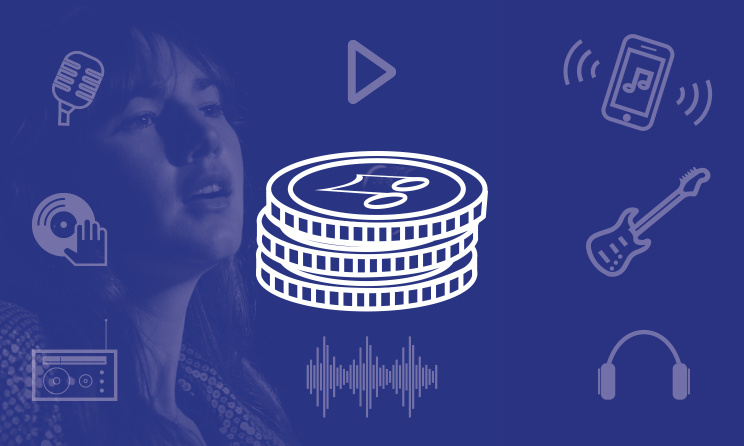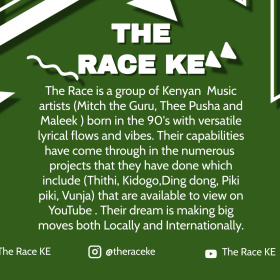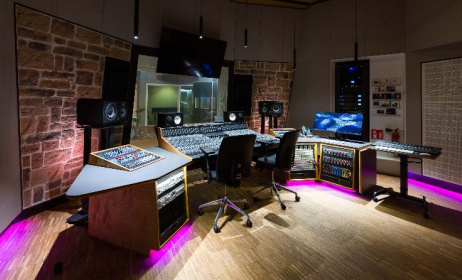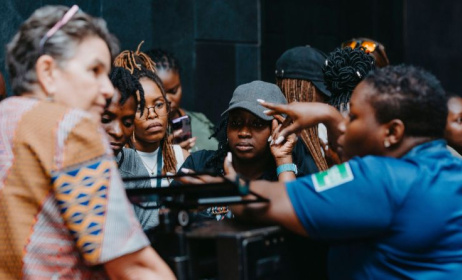How music copyrights generate revenue in South Africa
If you are unsure about how music copyrights in South Africa are structured, or how are they are distributed across the music industry, we recommend that you begin with our overview of music copyrights in South Africa article.
What are royalties?
When a copyright generates revenue, it is called a royalty. The rights afforded to copyright owners generate royalties in many ways. This means that when performance, mechanical and needletime rights are used, they generate performance, mechanical and needletime royalties.
Music copyrights generate revenue, in the form of royalties, in much the same way as other assets, such as a house, might be used.
- Music rights holders can sell their rights to music publishers and/or record companies, thus transferring either whole or partial ownership of these rights to another party, known as an assignment of copyrights. (For more information about this revenue stream, please see our article on publishing and recording deals in South Africa.)
- However, just like the owner of a house may, instead, rent out the property to generate revenue, you can do the same with a musical copyright in order to earn royalties. This process is called licensing – in other words, providing a licence that gives someone else permission to use the copyright.
Generating revenue with copyrights: Licensing and usage
Licensing is the act of a rightsholder giving legal permission to a person or organisation that would like to use their copyrighted work(s).[1] For a licence to be considered legal, it must be granted by the owner of the copyright and ideally needs to be made in writing. The licence should specify exactly what the work can be used for and how long it can be used, and should make it clear that this permission is granted by the licensor (the rights holder) to the licensee (the person/organisation using the copyrighted works) and nobody else.[2]
Certain licences are acquired as blanket licences, which means that the licensee can use as much music as they want from the collective management organisartion’s (CMO’s) catalogue, and then report how it was used afterwards – for example, musical work public performance licences for radio stations. Other licences are for single and specifically determined types of usage and need to be negotiated on a case-by-case basis (e.g. sync licences).[3]
In either case, however, the transaction is essentially the same: legal permission to use the copyright is given by the rights holder (licensor) to the music user (licensee), in return for a fee (royalty).
Common types of music licences
Mechanical licences
A mechanical licence allows the licensee to reproduce an existing composition in any way via a mechanical or digital process. This includes converting a recording of a composition from one format to another – such as putting a tape recording onto a vinyl record or a digital file onto a CD – or moving a digital file from a server to a hard drive (downloads) or to a device via a digital service provider (streaming).[4] Like all the types of music licences explored later on, usage of mechanical rights is a licence fee paid to the owners of the publishing rights of a musical work – i.e. the songwriter or publisher).
Strictly speaking, a mechanical licence is needed to create the recording in the first place, but, through historical recording industry ‘published price to dealer agreements’ (PPD agreements), it is now customary that a licence is needed when you distribute the recording in any way. This means that mechanical licences need to be obtained for each unit of each format the recording is released in.
If the licensee wants to put music onto a physical format – like a CD, vinyl or cassette tape – a fee is charged per unit that is produced. If the licensee wants to distribute the recording digitally – via streaming, downloads, online radio, etc. – they need to obtain a digital use licence, which is a sub-type of the mechanical licence, to ensure that all relevant publishing royalties find their way to the correct licensors (i.e. publishing rights holders).[5]
In South Africa, the Composers, Authors and Publishers Association (CAPASSO) is the organisation that administers mechanical licences. The CMO administers millions of songs and – through its association with the Southern African Music Rights Organisation (SAMRO), the International Bureau of Companies Managing Registration and Mechanical Reproduction Rights (BIEM), the International Confederation of Societies of Authors and Composers (CISAC) and various other global licensing bodies – are able to approve a licence of virtually any musical composition for any type of reproduction.[6] Mechanical licence fees are prenegotiated and standardised by CAPASSO, in collaboration with record labels, trade organisations and online music stores operating in South Africa.[7]
Synchronisation licences
Also known as ‘sync’ licences, these allow the licensee to reproduce a musical composition in timed relationship with visuals – for example, adverts, TV shows, films, video games, etc. It is a licence fee paid to the owners of the publishing rights of the composition (the songwriter or publisher). Sync licences are more challenging to obtain because no standard rate or fee is legislated or used, and there is no CMO that is designated to administer commercial music, except in the instance of production music libraries, which are administered by CAPASSO. In other instances, rights owners must be contacted directly and the sync licence fee must be negotiated.[8]
For a more in-depth discussion of synchronisation licences – including the royalties they generate and how to collect these royalties – please see our article on understanding sync licences in South Africa.
Master use licences
Master use licences are similar to sync licences, except that they give the licensee permission to use all or part of an existing recording (distinct from the music). It is a licence fee paid directly to the owners of the recording. Similarly to sync licences, they need to be obtained directly from the rights holders (record companies or artists) because no standard rate or fee is legislated or used, and there is no official CMO that administers them.[9]
Sample clearances
Artists creating their own music productions who sample other recordings should note they will need to obtain sample clearance licences for each sample they use – whether they use a tiny piece of an existing recording or the whole thing. It is therefore advisable that you obtain sample clearance licences before using any samples, as it is possible for existing rights holders to refuse to grant these licences. This would mean that your new recording cannot be used commercially – i.e. distributed or released to the public).
Furthermore, once a sample clearance licence has been granted, the licensees must also contact the owners of the publishing rights to obtain permission to use the underlying composition of that recording.[10]
Public performance licences
Public performance licences allow the licensee to play music in public, either via a recording or live music performance. This includes music played in any public place – like shops, public transport, clubs, live music venues or festivals – by any means such as broadcast, transmission or live performance.[11] These licences generally come in the form of blanket licences to make music usage and licence administration easier.[12]
There are various components to a public performance licence:
- If an existing composition is performed by a live band or performer, the owners of the publishing rights need to be paid, via SAMRO. Generally, it is the responsibility of the organiser or venue to pay this licence fee.
- If a recording is used, the owners of the sound recording rights need to be paid, as well as the owners of the performing rights, via the South African Music Performance Rights Association (SAMPRA) or the Independent Music Performance Rights Association (IMPRA). Again, this fee should be paid by the owners or managers of the public venue as per the Performers Protection Act.[13]
- If the work is used in a broadcast, a mechanical licence fee and a public performance fee needs to be paid to the owners of the composition, and a public performance fee needs to be paid to the owners of the recording and the performers, should they have an interest in the recording, via CAPASSO, SAMRO and SAMPRA, respectively.[14]
According to Music In Africa’s Revenue Streams for Music Creators in South Africa 2022 report, public performance royalties generated an average monthly income of R9 099. For more information about public performance royalties, please see our article on understanding broadcasting royalties in South Africa.
Print licences
A print licence allows the licensee to print lyrics and/or sheet music of a composition that they do not own. It is a licence and fee that is negotiated with and paid directly to the licensor – i.e. the owner of the publishing rights.[15] Print licences are most often used when choirs or orchestras perform a work, as each musician requires the music to read, or when creating a book of sheet music.[16] This process is either directly negotiated with the rightsholders, or else administered through the Dramatic, Artistic and Literary Rights Organisation (DALRO).
Theatrical licences
A theatrical licence, like a sync licence, allows the licensee to use an existing composition or recording that they do not own in a theatrical performance – for example, opera, play, musical, etc. It is a licence and fee that is negotiated with and paid directly to the licensee (in the case of a composition, the owners of the publishing rights; in the case of a recording, the owners of the publishing rights and the owners of the neighbouring rights).[17]
In the case of theatrical licences, a licence fee is charged each time the copyrighted work is used – in other words, each time the dramatic production is performed.[18] If you wrote your own musical, or dramatico-musical work, you would have ‘grand rights’ for that whole production.
Lastly, other copyrights can generate royalties similarly, such as music videos (cinematographic works) receiving performance royalties when they are broadcast. These are collected by the Recording Industry of South Africa Audio Visual (RAV) or the Association of Independent Record Companies of South Africa (AIRCO).
Resources and citations
- [1] Musicbed. (2022). "Types of Music Licenses”. Accessed on January 29, 2022: https://www.musicbed.com/knowledge-base/types-of-music-licenses/28
- [2] Ibid.
- [3] Dean, 2006: 1-33
- [4] Shaw, JG. (2017). The South African Music Business (Third Edition). ada enup: pp.75-77
- [5] Musicians Institute Library. (2021). "Licensing in a Nutshell”. Accessed on January 29, 2022: https://library.mi.edu/musiccopyright/licensing
- [6] CAPASSO. (2021). “Music licensing”. Accessed on January 29, 2022: https://www.capasso.co.za/music-licensing/
- [7] Ibid.
- [8] The Modern Musician. (2018). "What is Synchronization License & Sync Licensing?” YouTube. Accessed on January 29, 2022: https://youtu.be/rnUtUq25ECI
- [9] The Music Business Made Easy. (2019). “Understanding the Master Use License”. YouTube. Accessed on January 29, 2022: https://youtu.be/YR-rka8PMwc
- [10] FindLaw. (2016). "Obtaining Permission before Sampling Music”. Accessed on January 29, 2022: https://www.findlaw.com/smallbusiness/intellectual-property/obtaining-permission-before-sampling-music.html
- [11] Matzukis, N. (2014). South African Music Law, Contracts & Business - Fourth Edition. Academy of Sound Engineering: p. 39
- [12] The Kiffness. (2020). “5 steps to making sure you get paid your SAMRO royalties”. Accessed on January 29, 2022: https://www.thekiffness.com/2020/5-steps-to-making-sure-you-get-paid-your-samro-royalties
- [13] SAMPRA. (2019). “The Royalty Value Chain: The difference between needletime rights, performing rights and mechanical rights”. Accessed on January 29, 2022: https://www.sampra.org.za/the-royalty-value-chain-the-difference-between-needletime-rights-performing-rights-mechanical-rights/
- [14] CAPASSO. (2021). Ibid.
- [15] EasySong. (2020). “Music Licensing for Print”. Accessed on January 29, 2022: https://support.easysong.com/hc/en-us/articles/360039405974-Music-Licensing-for-Print
- [16] Sound Reef. (2012). "What are the different types of music licences?”. Accessed on January 29, 2022: https://www.soundreef.com/en/blog/music-licenses/
- [17] EasySong. (2020). “Music Licensing for Stage”. Accessed on January 29, 2022: https://support.easysong.com/hc/en-us/articles/360039887753-Music-Licensing-for-Stage
- [18] Musicbed. (2022). Ibid.
This article is part of the Revenue Streams for African Musicians project, supported by UNESCO’s International Fund for Cultural Diversity in the framework of the UNESCO 2005 Convention on the Protection and Promotion of the Diversity of Cultural Expressions, the Siemens Cents4Sense programme, Siemens Stiftung, Goethe-Institut, the National Arts Council of South Africa and Kaya FM.
Editing by David Cornwell and Kalin Pashaliev































Comments
Log in or register to post comments